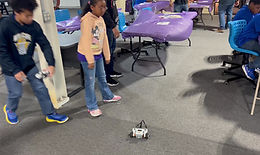How Communities Can Thrive Through Collective Action
- Henry Washington
- May 22
- 4 min read
Across the globe, communities are facing numerous challenges. From environmental issues to social injustices, the need for unity and action has never been greater. Collective action can empower a community, allowing individuals to band together for a common cause, ultimately leading to sustainable community growth. This blog post will explore the significance of collective action and how communities can thrive through it.
The Importance of Community Growth
Community growth extends far beyond mere population increases. It encompasses the enhancement of local resources, the strengthening of social ties, and the promotion of wellbeing among residents. Active community participation helps develop a sense of belonging, as individuals work together toward shared goals.
Numerous studies indicate that communities that actively participate in collective action see higher rates of economic development. For instance, a report from the Institute for Community Development found that neighborhoods that cultivate local initiatives experience a 30% increase in local businesses.

Moreover, collective action fosters collaboration among various community sectors—nonprofits, businesses, and government agencies. When these entities work together, problems are tackled more effectively. Regular collaboration not only leads to innovative solutions but also enhances trust and relationship-building within the community.
Understanding Collective Action
Collective action refers to the various ways in which individuals come together to achieve a common goal. This collaboration can manifest in several forms, such as neighborhood clean-ups, food drives, or advocacy for policy changes. The essence of collective action lies in the belief that together, individuals can achieve what they cannot do alone.
To effectively mobilize a community, it is essential to build strong networks. One successful example comes from the neighborhood revitalization projects in the Bronx, New York. Community members organized focus groups to identify local needs, leading to a combined effort that transformed neglected spaces into vibrant community gardens.
Collective action can also empower marginalized voices. For instance, the rise of community organizing in urban neighborhoods has provided platforms for residents to express their concerns and propose solutions. Organizations working at the grassroots level often serve as facilitators, guiding communities towards collective goals while offering support.

What is Community Empowerment?
Community empowerment is the process through which individuals gain confidence, skills, and resources to advocate for themselves and their community. This concept is vital in fostering a spirit of collective action since empowered individuals are more likely to engage in initiatives aimed at improving their environment.
Furthermore, community empowerment encourages residents to actively participate in decision-making processes. When people have a stake in their community, they are more likely to contribute positively. Programs aimed at fostering leadership skills among community members have shown promising results.
According to a 2020 analysis by the World Health Organization, communities that engaged in empowerment initiatives reported a 40% increase in residents' participation in local governance. A prosperous community is one where everyone has the opportunity to take part and contribute.
Strategies for Successful Collective Action
Engaging in collective action is easier said than done. However, certain strategies can improve the chances of success for community initiatives:
Build Strong Relationships: Strong partnerships are vital. By nurturing relationships among community members, stakeholders, and organizations, trust is established. Regular communication and collaboration create a sense of shared purpose.
Define Clear Goals: For any initiative to be effective, it must have clearly defined objectives. Community members should work together to identify specific, measurable goals that reflect the community's needs and desires.
Leverage Local Resources: Every community boasts its unique skills and assets. Whether it is local businesses, talented individuals, or community organizations, leveraging these resources can enhance collective action efforts. Encouraging local support not only strengthens initiatives but also fosters pride in the community.
Create a Sustainable Framework: Planning for the long-term is vital. When initiating collective action, communities should consider how projects will be sustained over time. This entails involving local leaders and stakeholders to ensure that the efforts continue past the initial phase.
Share Success Stories: Highlighting success can inspire others. Whether through social media or local newsletters, sharing positive outcomes of past initiatives encourages community members to engage in future projects.

Overcoming Challenges in Collective Action
Despite the numerous benefits associated with collective action, communities often face challenges. Common roadblocks include differing opinions, lack of resources, and complacency among residents. Addressing each of these obstacles is crucial for successful collaboration.
One way to navigate differing opinions is through facilitation. By appointing a neutral facilitator, discussions can remain constructive, allowing diverse viewpoints to be acknowledged, and productive compromises to be reached.
Limited resources can be addressed by building partnerships with local businesses and organizations. Collaborative fundraising efforts or resource-sharing agreements can significantly enhance the capacity of community projects.
Finally, encouraging participation in initiatives can help combat complacency. Making activities accessible and engaging can motivate individuals to get involved. Offering variety and fun can attract wider attendance, ultimately leading to more successful outcomes.
The Path Forward: Envisioning Community Transformation
As communities strive to create positive change, the importance of collective action cannot be overstated. Each initiative, no matter how small, contributes to the overall growth and empowerment of the community.
Whether advocating for better local services, enhancing the environment, or developing social programs, collective action paves the way for sustainable futures. It highlights the importance of each individual's contribution to a greater cause.
In harnessing the power of community, groups can explore the potential of their collective strengths. Engaging with a shared vision inspires concerted efforts, transforming aspirations into reality. By embracing collective action, communities will not only survive but thrive, nurturing a culture rich in collaboration and connection.
Regular engagement, shared learning, and determination will ensure that the future of communities is bright. If you are eager to explore how to achieve effective community empowerment, organizations like the HW3 Foundation are also available to provide guidance.
Communities that unite in action will unlock their true potential. Embrace your community's journey toward growth today!



